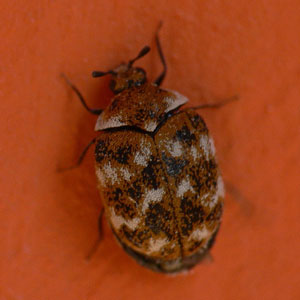Carpet Beetle Source Can Be Hard to Find
By Chris Williams on July 19, 2013.

Question
We’ve had an ongoing, on again, off again problem with carpet beetles in our home. We’ve had the whole house treated twice but we still have them. We can’t figure out why; we don’t have any woolen carpets. We can’t find a source for the beetles. We just see them on walls and floors in several different rooms. Can you help?
Answer
Not having found a good source for the beetles is a problem because carpet beetle larvae feed on so many different things. That’s one thing you need to know—it’s the larvae that do the feeding damage. The adult beetles don’t feed but they can fly, so finding beetles in various rooms isn’t much of a clue as to the actual location of the infestation.
The larvae feed on many things but primarily on woolens (carpets, clothing, blankets, etc.), hair, hides, dead insects, pet food and other food crumbs. The larvae are yellowish-brown, about ¼-inch long, and covered with bristly hairs. They avoid light, remain hidden, and are rarely noticed—although you may find their shed skins in or near the food source. You don’t say whether or not you have pets. For many people with carpet beetles, it’s simply a matter of lots of stray pet hair and food crumbs under furniture and in corners—and not enough vacuuming.
It’s possible that the source of the infestation is not even in the living areas of your house, but is in the attic, or a wall void, or on the exterior, and emerging adult beetles are just finding their way into your house. This might explain why two treatments have had little effect. Here are two possible scenarios:
1) Infestation in the attic
Carpet beetles feed on accumulations of dead insects. If you’ve had any problems with overwintering insects like Asian lady beetles, cluster flies, or brown marmorated stink bugs, there could be accumulations of these dead insects in your attic—enough to feed a few generations of carpet beetles. The larvae could also be associated with a bat roost or squirrel nest in the attic where they feed on accumulations of hair and droppings.
2) Infestation in nests or carcasses in voids
Carpet beetles sometimes end up in homes when there is a bird nest in a vent, air conditioning unit or other structure on the building. Beetle larvae feed in nests on feathers, bird poop, and dead baby birds. The source of the infestation can also be hidden inside a wall or ceiling void. Carpet beetles are found in wasp or bee nests which can sometimes be inside wall voids. They can also be feeding in mouse, rat, or other animal nests that can be located inside voids, garages, or crawlspaces. Finally, the larvae will feed on the hidden carcasses of dead rodents or other animals which have died inside wall voids, chimneys, or in other hidden places. Unless the carcass can be located and removed or the void space treated, the infestation will continue until the carcass is just bare bones.
After the larvae have completed development, they pupate and emerge as adult carpet beetles. Unlike the larvae, the beetles are attracted to light so they may find their way out of the attic or void space and into living spaces. With this information, maybe you or your pest control professional can narrow down the search for the source of the infestation. Good luck.
Photo credit: Walwyn / Foter / CC BY-NC-SA